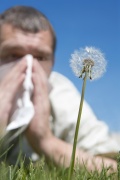Environmental Allergies
|
Environmental Allergies | |
| Causes | Food Reactions, Smoking, Allergies, Infections, Environmental Toxins, Stress |
|---|---|
| See Also | Respiratory Conditions, Infections / Allergies / Sensitivities, Food allergies, Food intolerances, Food Additives, Asthma, Bronchitis, Hayfever |
| Books | Books on Head, Ears, Nose and Throat Conditions |
| Articles | Articles on Head, Ears, Eyes, Nose and Throat Conditions |
Environmental allergies, also known as seasonal allergies, hayfever or allergic rhinitis occur when your immune system overreacts to particles in the air that you breathe. Your body's defence system (immune system) attacks the particles in your body, causing symptoms such as sneezing and a runny nose. The particles are called allergens because they can cause an allergic reaction.
Acute and chronic allergic diseases are a leading cause of work and school absenteeism, and can impair the ability of individuals to carry out common daily activities. It is estimated that in the USA alone over 8 billion dollars is spent annually to treat allergic symptoms.[1]
Naturopathic Assessment
| Article | Do Environmental Toxicants Contribute to Allergy and Asthma? , Alt Med; 2012;Vol17(1) |
|---|
Causal Factors
In order to stimulate the innate ability of the body to heal the causes of disease must be identified and addressed. With allergies, the causes are variable and include lifestyle and environmental factors.
Lifestyle
- Nutrient deficiencies, food intolerances, food allergies and sensitivities to food additives can increase a person's susceptibility and risk of developing environmental allergies.
Social
- Stress can increase a person's susceptibility to environmental allergens.
Environmental
- Urban Living
- Individuals raised in urban environments have a higher incidence of allergic disease.[2]
- Outdoor Allergens
- Pollens are a major allergen implicated in environmental allergies. Often referred to as hayfever, allergies to pollens generally present with runny nose, watery eyes, and sneezing. The most common pollen triggers are:
- trees,
- grasses, and
- weeds.
- The types of pollen that most commonly cause allergic reactions are produced by plants (trees, grasses and weeds) that do not have large flowers. These plants create small, light, dry pollen granules that can travel long distances through the air. Most allergenic pollen comes from plants that produce it in huge quantities. A single ragweed plant for instance can generate a million grains of pollen a day.
- Reactions to pollen is seasonal.
- Spring: tree pollen
- June: grass pollen
- August and early September: ragweed.
- Fall: Mould from leaf litter
- Household Allergens
- Household dust is composed of bacteria, plant and animal matter, human skin cells, food, fungi, animal dander, and dust mites. This can be an important source of air borne allergens.[3] The most common household allergens are:
- dust mites
- animal dander
- cockroaches, and
- mould.
- Workplace Allergens
- The most common workplace triggers include:
- cereal grain
- wood dust
- chemicals
- animals.
- Air Pollution
- Air pollution may exacerbate symptoms of allergies, and may increase an individual's succeptibility to developing allergies.[2]
External
- Smoking, even second-hand smoke is correlated with increased risk of environmental allergies.
Genetics
- Family History
- There is a well known link between atopic conditions and family history. Several genes have been identified that increase levels of circulating IgE and may predispose an individual to developing allergic conditions. Other genes strongly linked to the development of allergies include cell adhesion genes, cell signalling genes, and the major histocompatibility comples or HLA. [4]
Diagnostic Testing
Suspicion of environmental allergy should be followed by a comprehensive health history and a focused physical examination (specifically an ear nose throat examination). The best evidence for environmental allergies in an individual is if he or she can link specific exposure to the onset of allergy symptoms.
The following diagnostic tests are used to evaluate environmental allergies:
- Skin-prick testing is commonly performed to evaluate potential allergens. It is estimated that 6 common airborne allergies are responsible for 95% of allergy cases.
- IgE serum testing for specific antibodies can be performed to identify allergies, but this method is generally considered less effective than skin-prick testing but is less invasive.
It is important to note that positive laboratory tests without correlating clinical evaluation cannot confirm the presence of allergies.
Related Symptoms and Conditions
Individual's with environmental allergies either commonly have the following conditions or they are at increased risk of developing the following conditions:
- food allergies
- food intolerances
- increased sensitivity to food additives
- asthma
- bronchitis
- Hayfever
Characteristics
There has been a marked increase in allergic conditions in the past few decades, and although the exact cause is unknown there exists several hypotheses. A theory known as the "Hygiene Hypothesis" suggests that decreased exposure to microorganisms in childhood in developed countries, leads to improper development of the adaptive immune system and a subsequent increased risk of allergic disease.[4]
Common Symptoms
Common signs and symptoms associated with seasonal and environmental allergies include:[3]
- Paroxysmal sneezing
- Nasal congestion
- Postnasal drip
- Sinus congestion
- Watery eyes
- Nosebleed
- Sleep disturbance
Naturopathic Treatment
The goal of naturopathic treatment is to support and work in tandem with the healing power of the body and to address the causal factors of disease with individual treatment strategies. Environmental allergies are typically a chronic disease, yet they can be resolved when the immune system is rebalanced.
It is always advisable to work with a naturopathic doctor before engaging in any treatment plan.
Home Care
Home Care strategies include: The following guidelines can decrease your exposure to environmental allergens:
- Household recommendations:[1]
- Remove household carpets and replace curtains with shades.
- Dust-mite proof pillow and mattress covers are your first line of defense against dust mites. It is also helpful to wash bedding, especially pillow cases more frequently during allergy season.
- Limit access of pets to specific areas of the home. Bathing pets more frequently can also be beneficial.
- Installation of a HEPA (high-efficiency particulate air) filter can all help to reduce the severity of allergies.
- A cool-mist humidifier can help to lessen nasal congestion and wheezing.
- If you have a lot of carpets a dehumidifier can help keep dust mites under control and can prevent mold.
- Clean your furnace/air-conditioner filter frequently to remove pollen.
- During Allergy Season
- Stay inside when pollen counts are high (mid-day to late afternoon). Pollen counts are generally lowest just after sunrise.
- Watch local weather reports for local pollen counts.
- Keep windows closed and use air conditioning at home and in the car to reduce exposure to outdoor pollens. If a window-type air conditioner is used, keep the vent closed.
- Do not use a fan with an open window, as this can bring more pollen into your home.
- Keep exercise and outside work limited to times when the pollen count is low.
- Take your holiday during the peak of the pollen season in a place where the plants you are allergic to don't grow.
- Mow your grass often. If possible, have a family member or friend do it for you. If this is not possible wear a dust/pollen mask while you mow.
- Avoid places with lots of weeds and tall grasses, like parks or fields.
- Wear wrap-around sunglasses to prevent pollen from blowing into your eyes.
- Avoid people that smoke. Tobacco is a notorious irritant that increases allergy symptoms.
- After you have been outside for awhile it is best to have a hot shower to lessen symptoms like sneezing and congestion. Washing your hair can help decrease the pollen that collects on the hair.
- Breathing in steam refreshes and soothes irritated sinuses and decreases mucous in the nasal passages.
- If your eyes are bothering you try rinsing them cool, clean water.
Lifestyle
Lifestyle recommendations include:
- Any food sensitivities are best avoided during allergy season.
- Consumption of a diet high in antioxidants, cooked vegetables, tomatoes, and fruit have been shown to protect against respiratory affects of allergies.[1]
- Foods that are best avoided include: sugar, dairy, bananas and food additives.
- Foods that may be beneficial include: omega-3 rich foods, peppermint tea, honey, horseradish and wasabi.
- Ensure you drink adequate water.
- Avoid foods that have a cross-reactivity to your specific allergy.
- Planning outdoor activities to reduce exposure to early morning peak pollen is recommended.
- Deep breathing and other breathing exercises can be beneficial in decreasing congestion.
- Mind-body therapies have been shown to effectively decrease allergic response to seasonal allergens.[1]
- Stress reduction exercises can minimize allergy symptoms.
Naturopathic Therapies
The prescribing of naturopathic therapies requires the guidance of a naturopathic doctor as it depends on a number of factors including the causal factors, a person's age, prescription medications, other conditions and symptoms and overall health. It is always advisable to work with a naturopathic doctor prior to taking any natural therapies.
Naturopathic Therapies for environmental allergies include:
- Vitamins such as vitamin C, Vitamin D
- Minerals such as selenium, magnesium
- Other supplements such as Quercetin, Bromelain, Omega-3 Fatty Acids, Melatonin, Acidophilus, Spirulina
- Herbs such as:[1][7]Butterbur (Petasites hybridus), Chamomile (Matricaria recutita), Nettle (Urtica dioica), Peppermint (Mentha piperita, Ephedra (Ephedra sinica), Siberian Ginseng (Eleutherococcus senticosus), Reishi (Ganoderma lucidum), Ginseng (Panax ginseng)
- Gemmotherapies such as Abies alba, Alnus glutinosa
- Homeopathics inluding Allium cepa, Euphrasia
- Studies have demonstrated that combining acupuncture and chinese herbal formulations can be effective in the treatment of seasonal allergic rhinitis.[8]
- Hydrotherapy, such as steam inhalation and saunas can be effective in relieving allergy symptoms.
- Other Therapies
- Sublingual Immunotherapy (SLIT) is common in Europe, and is gaining popularity in North America. Studies have shown that SLIT is safe and effective in the treatment of both aeroallergens and food allergens.[1]
References
Reviewed by Iva Lloyd, BScH, RPE, ND [1]
- ↑ 1.0 1.1 1.2 1.3 1.4 1.5 1.6 Horwitz RJ (2012) Rakel: Integrative Medicine 3rd ed Chap 29 The Allergic Patient Saunders
- ↑ 2.0 2.1 Tan EA, Matsui E, Wiesch DG, Samet JM (2008) Adkinson: Middleton's Allergy: Principles and Practice, 7th ed Chap 42 Epidemiology of Asthma and Allergic Diseases Mosby
- ↑ 3.0 3.1 3.2 Hernandez-Trujillo V, Mitchell G, Lieberman P (2011) Rakel: Textbook of Family Medicine, 8th ed Chap 20 Allergy Saunders
- ↑ 4.0 4.1 Homburger HA (2011) McPherson: Henry's Clinical Diagnosis and Management by Laboratory Methods 22nd ed Chap 54 Allergic Diseases Saunders
- ↑ Baroody FM, Naclerio RM (2010) Flint: Cummings Otolaryngology: Head and Neck Surgery, 5th ed Chap 40 Immunology of the Upper Airway and Pathophysiology and Treatment of Allergic Rhinitis Mosby
- ↑ Kidd P (2003) Th1/Th2 Balance: The Hypothesis, its Limitation, and Implications for Health and Disease Alt Med Rev 8(3):223-246
- ↑ Godfrey Anthony, Saunders Paul Richard, Barlow Kerry, Gilbert Cyndi, Gowan Matthew, Smith Fraser (2010) Principles and Practices of Naturopathic Botanical Medicine, Vol 1: Botanical Medicine Monographs, CCNM Press, Toronto
- ↑ Brinkhaus R, Hummelsberger J, Kohnen R, et al (2004) Acupuncture and Chinese herbal medicine in the treatment of patients with seasonal allergic rhinitis: a randomized-controlled clinical trial Allergy 59:953-960

